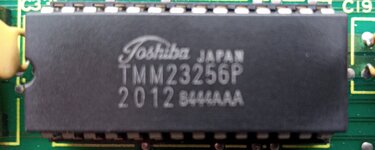Deviousdexter
Junior Member level 1

- Joined
- May 1, 2024
- Messages
- 16
- Helped
- 0
- Reputation
- 0
- Reaction score
- 0
- Trophy points
- 1
- Location
- UK
- Activity points
- 177
Hello
I hope this the correct place to post this, feel free to move it if not.
Please excuse my ignorance but i require some knowledge please. I have an old 8 bit computer which i believe needs the BIOS Rom replacing, my intention is to replace it with an Eprom and flash it myself. I have purchased a cheap programmer form China and downloaded some software which i believe to be compatible. However, nothing i look at seems to list the chip i am trying to flash.
The original chip is a Toshiba TMM23256P which i would like to replace.
The replacement is an AM27C256-120DC which i think is an AMD IC (??)
( This is UV Erasable ? Is it usable or do i need something else?)
Pics attached.
The programmer is a SP200S-V2.00 which connects via USB using a CH340 Driver. And i have ASprogrammer. NEOprogrammer and WLPro-V220 that seem to lauch ok but not detect or list the specific chip(s) i have.
Do i need a different chip, a different program(s) or is this possible with what i have? All i have in way of a UV light is a curing light for solder mask, is this useable or not ?
Any advise is greatfully received.
thanks
I hope this the correct place to post this, feel free to move it if not.
Please excuse my ignorance but i require some knowledge please. I have an old 8 bit computer which i believe needs the BIOS Rom replacing, my intention is to replace it with an Eprom and flash it myself. I have purchased a cheap programmer form China and downloaded some software which i believe to be compatible. However, nothing i look at seems to list the chip i am trying to flash.
The original chip is a Toshiba TMM23256P which i would like to replace.
The replacement is an AM27C256-120DC which i think is an AMD IC (??)
( This is UV Erasable ? Is it usable or do i need something else?)
Pics attached.
The programmer is a SP200S-V2.00 which connects via USB using a CH340 Driver. And i have ASprogrammer. NEOprogrammer and WLPro-V220 that seem to lauch ok but not detect or list the specific chip(s) i have.
Do i need a different chip, a different program(s) or is this possible with what i have? All i have in way of a UV light is a curing light for solder mask, is this useable or not ?
Any advise is greatfully received.
thanks




